1735 Vine St. Los Angeles, CA 90028 | map |
Also see: Hollywood Playhouse / Avalon: interior views
The Hollywood Playhouse, after many incarnations as a legitimate theatre and television studio, is now a music venue. That's the Hotel Knickerbocker behind the theatre. Photo: Bill Counter - 2022
Opened: January 24, 1927 as the
Hollywood Playhouse, the last of four major legitimate theatres to open in
Hollywood in less than nine months. The earlier ones were the
El Capitan (May 3, 1926), the Music Box, now called the
Fonda Theatre (October 20, 1926) and Wilkes Vine Street, now the
Montalban (January 19, 1927).
An early drawing for the project that appeared in the October 1925 issue of Los Angeles Realtor as part of a collage titled "Five New Playhouses for Hollywood." The others were the Warner, Chinese, Music Box and El Capitan. It appeared again in the November 1926 issue, that time as part of "The Home of the Theatre," another full page spread that also included the Egyptian. They noted "Hollywood theaters are famous the world over." Thanks to the Special Collections Division of the Los Angeles Public Library for making the issues of the magazine available.
A November 1, 1925 L.A. Times article about the project.
An April 28, 1926 Times article announcing the "launching of construction work."
The opening show was announced in a January 2, 1927 L.A. Times article: "'Alias the Deacon' Set For New Hollywood Playhouse." The play featured Berton Churchill, then the biggest star on Broadway. Thanks to Mike Hume for locating the article and making it available as a
PDF via the page about the theatre on his
Historic Theatre Photography site.
"Hollywood Becoming Another White Way of Show World" was the headline for a full page in the L.A. Times issue of January 16, 1927. Times critic Edwin Schallert discussed the Playhouse and the Vine Street along with other new Hollywood theatres. Mike Hume has the page available as a
PDF. Some of the comments related to the Playhouse:
"Diversified Character Found in New Theaters... The theaters of Los Angeles and Hollywood are assuming as diversified a character in their policy of play presentation as they are in the matter of architecture. This fact is especially evidenced in the completion of two new institutions dedicated to the spoken drama, which will open their doors within the next two weeks in the cinema metropolis. These are, respectively, Wilkes Vine Street Theater, and the Hollywood Playhouse. Both of them are located on Vine street, but so close to Hollywood Boulevard, that the lights that announce their luminous presence will be plainly visible on that main and now glittering artery of traffic -- fast becoming a new White Way of the show world.
"With the completion of these two theaters, and the early premiere of Grauman's new Chinese Theater, Hollywood will have six houses dedicated to first-run entertainment, both in plays and pictures. These include Grauman's Egyptian, the oldest established, in which United Artists is now interested; El Capitan, which plays spoken drama attractions; and the Music Box, given over to the light and popular fare of revues. Six theaters is regarded as an accomplishment for a community which is, strictly speaking, a part of Los Angeles, but which is managing more and more to acquire its own independence, even as it has long possessed a distinct individuality...
"The Hollywood Playhouse... may be described as entirely different from any theater in that it offers to view as one enters a grand staircase, modeled in a general way after the European continental plan. By this means access is gained to the balcony and also to the open-air patio that serves as a lounge. Entrance to the lower floor is through doorways on either side of this staircase. 'Beside its ornamental features, we have felt that the grand staircase would be a distinctly important departure in many ways,' declared Edward W. Rowland, managing director of the theater. 'We want among other things to give the balcony some of the attractiveness that it has lost in recent years. We intend to cater in as popular and democratic a way as possible to the public of this locality...' "
A pre-opening entrance detail. Thanks to the Bruce Torrence
Historic Hollywood Photographs
collection for the photo, their #T025-13. Many more photos of the
theatre are in the collection including several as the Hollywood Palace:
a
1972 view, #T-001-1 and a
1978 view, #T-024-2. Take a tour through nearly 250
theatre photos on the site. Thanks, Bruce!
In "Playhouse In Bright Debut," Edwin Schallert's January 26, 1927 Times review, he declared that "Alias the Deacon" was an "amusing attraction" and the new theatre was a "beauty." Thanks to Mike Hume for locating the article and making it available as a
PDF. Some of Schallert's comments about the theatre:
"New Hollywood Theater Strikes Popular Note... This is a nifty. Both are in fact -- the play and the playhouse, and don't miss this one, or wait until the next production blooms to see the other. And if somebody should say quite cynically that there 'Isn't going to be any next production,' what with all the theaters throwing their doors open hereabouts, why give him the steely glance. For this little house in the suburbs, if you want to call Hollywood with its newly acquired Gay White Way the suburbs, is destined from all prospects for a big and popular hit...
"Anyway, the Hollywood Playhouse has arrived, and it is a beauty, what with a grand staircase and a patio, not to speak of an electric lighting equipment that provided a special thrill for those who attended the premiere. Comfortable seats and luxurious appointments -- warmth betokened from floor to ceiling -- these are among its distinguishing features. Ornateness and intimacy -- one can go right on calling forth the words that fit a description. A Spanish motif in the architecture -- that's not to be forgotten -- nor the two pepper trees in front either. Altogether it is something to visit, and as soon as possible to be up to the minute because it happens to be different.
"The Hollywood Playhouse is the second to increase the illumination of Vine street within the past ten days. It is only a block away from the Vine-street Theater. And so this thoroughfare is suddenly acquiring a personality in the realm of entertainment... The theater itself is a fulfillment of a community effort, although it does not come in the classification of a community theater, and Ed W. Rowland, as its general manager, acts also as its official sponsor, although there are many other well-known people of the boulevard sector on the directorate... Edwards Davis made a splendid speech of dedication in which he spoke about the many theaters here as significant of the revival in the spoken drama..."
Never a film house, it's always been a live venue of some sort. After
its early legit career it became a TV studio. The building got a major
makeover in 2002.
Status: It's now a concert facility and music club called
Avalon Hollywood. Also in the building is
Bardot at 1737 Vine St., a somewhat separate
restaurant and club occupying the second floor areas fronting on Vine
St. as well as the rooftop patio behind those spaces. Use of all the areas is fluid depending on the requirements of a particular event. There are patio photos at the bottom of this page. Scroll down to the bottom of the
interior views page for several photos of the Bardot space.
Phone: 323-462-8900
Website: AvalonHollywood.com |
History |
Bardot |
Facebook |
Architects: Gogerty and Weyl. Henry L. Gogerty (1894-1990) and Carl Jules Weyl (1890-1948) also
designed many other Hollywood buildings. See some of their other projects listed on the
Theatres by Architect page. Steffan Horbaczek was responsible for the building's decoration. Earlier he worked as a painter for William Lee Woollett on the Metropolitan Theatre and also painted sets for the Los Angeles Grand Opera Association.
One sheet of the Gogerty and Weyl plans for the building from the collection of Joël Huxtable. He's a lighting designer who also took on the task of being the theatre's archivist until 2009. He's continued collecting material about the building.
The contractor was William Simpson Construction Co. This ad was spotted by Lisa Kouza Braddock in the January 27, 1927 issue of the Hollywood Citizen News. They were also the contractors for the
San Gabriel Mission Playhouse, opening three months later. They built the
Pantages, opening in June 1930, and did the 1954 renovations that turned the Vine St. into the
Huntington Hartford.
Seating: Originally 1,178. The main floor has been terraced and seats removed. In 1949 the capacity was listed as 1,142 with 656 of that on the main floor, 178 in the balcony loges, 296 in the balcony upper section and 12 in the boxes.
Stage specs: The proscenium is 37' 8" wide and 45' high. It's 34' 4" from the curtain to the backwall. The stage is 71' wall to wall. Grid height is 71'. It was originally a hemp house but a number of counterweight sets have been added. You'll find more details about the stage down near the bottom of the interior views page.
The Playhouse in the 20s:
A 1927 Mott Studios photo in the collection of the
California State Library. In the display cases are posters for the theatre's opening attraction, "Alias The
Deacon" staring Berton Churchill. There's also a version of this photo in the Bruce
Torrence
Historic Hollywood Photographs collection, #T-025-4. Also see an "Alias" photo in the
California State Library collection, with a cutout of Churchill.
The Mott Studios photos of the Playhouse in the California State Library
collection include many not shown here on this page. They're in four
sets:
5 photos - set # 01384357 |
15 photos - set # 01384349 |
patio - 3 photos - set # 01384348 |
lobby stairs - 3 photos - set # 01384347 |
Eight of the Mott Studios photos appear beginning on page 35 of the April 1928 issue of
Pacific Coast Architect. Thanks to Mike Hume for finding the issue on Internet
Archive. The publication mistakenly credits Morgan, Walls & Clements as designers of the building.
The theatre's initial operator, Ed Rowland, generally brought in
traveling shows, largely dramas. By 1928 Henry Duffy was booking his productions into the theate. Duffy also
produced at the El Capitan and at the President Theatre (the former Morosco, later renamed the Globe) downtown on Broadway. Noted performers in the early years of the Playhouse included the Duncan Sisters, Charlotte Greenwood, and Billie Burke.
Coming attractions were listed in the Hollywood Playhouse's opening night program.
The staff and policy page of the opening program. It's from the collection of Joël Huxtable.
The program cover for "If I Was Rich." The 1927 production featured Phil
Tead and Charles Miller. This image appeared on a now-vanished website
called Theatre Print.
A blurb about "Pomander Walk" that was located by April Clemmer. Visit the
April's Old Hollywood site for information on walking tours and special events she hosts. She's also on
Facebook.
Eugene O'Neill's "Anna Christie" replaced "Pomander Walk" in June 1928. Thanks to April Clemmer for locating the news item.
The Playhouse in the 30s and early 40s:
An early 30s
view of the Playhouse as we look north on Vine. It's a photo in the
Los Angeles Public Library collection.
The Library also has
another similar view.
Note that the roof sign doesn't say Hollywood Playhouse anymore, only "Playhouse."
Soon those letters would be removed as well.
The tall structure is the Pacific States Life Building, now known as the Yucca Vine Tower,
completed in 1928. It's also a design of Gogerty & Weyl. In a post of the photo on the
Lost Angeles Facebook page Andrew John Smith noted in a comment that to the left of the insurance building is the Yucca Market, a design by Lloyd Wright. In the center on the far left is a Van de Camp Bakery windmill at Yucca and Ivar, a building now Joseph's cafe. Also note
the Lake Hollywood Dam in the distance -- before being camouflaged by dirt
and foliage. It was completed in 1926.
In the mid to late 30s the Playhouse was used for a number of WPA Federal Theatre Project shows. This program cover is from the 1933 production of George Bernard Shaw's "Androcles and the Lion." This was the first of many FTP productions at the theatre. It's from Joël Huxtable's collection. "Androcles" was back for another run at the theatre in December 1937.
The "Androcles" cast onstage.
A nice 1934 view from the California Historical Society. Leon Gordon is appearing in "White Cargo." It's in the
USC Digital Library collection. The
production of the play at the Playhouse was mentioned in a news item in the Reading Eagle. Mr. Gordon was also the author of the play. A later production of it ran over a year at the Beaux Arts Theatre in 1939 and 1940. A version of the photo is also in the Bruce Torrence Historic Hollywood Photographs collection as their item #T-025-11.
Billy Minsky turned the theatre into a burlesque house with his show "Life Begins at Minsky's." Thanks to Ken McIntyre for sharing this August 1935 ad in a post for the private Facebook group
Photos of Los Angeles. While this ad calls it
Minsky's Music Hall, they were soon back to using the Hollywood Playhouse name.
A December 27, 1935 ad appearing in the Hollywood Reporter for Barney Gerard's "Follies of the Day."
A July 30, 1936 ad for the opening of "Hollywood Goes Minsky." Thanks to Larry Harnisch for including this in his
The Daily Mirror blog post about burlesque star Carrie Finnnell. Later she appeared downtown at the Follies. Larry's post also includes an August 12 story about this Minsky show getting shut down by the vice squad with thirteen members of the troupe arrested.
A poster in the
Library of Congress collection for 1937's "Revue of Revues" by the Federal Theatre Project at the Hollywood Playhouse.
George Mason University has a different
"Revue of Reviews" poster in their collection.
A flyer for a December 1937 Federal Theatre Project Children's Festival. Thanks to Ken McIntyre for locating it for a post for the Photos of Los Angeles private Facebook group.
A c.1938 look down on the Playhouse from Life. The banner is touting stage shows at popular prices. The title of the show on the marquee seems to be something called "Black Empire." Check out the new "Vodvil Playhouse" sign on the roof above the entrance.
Another c.1938 aerial photo from Life. The Hollywood Playhouse is down in the lower left corner. Thanks to Noirish Los Angeles contributor Tourmaline for finding the two Life aerial shots. They appear, along with several recent views of the building, on Noirish Los Angeles post #35795.
A 1939 L.A. Times ad. Thanks to Ken McIntyre for locating this one for a post for the Photos of Los Angeles private Facebook group. Also see the Federal Theatre Project Materials Collection items
at George Mason University. Type "Hollywood" as a search by subject and you can get the eight items in their collection. You can search their site by city, show
title or theatre name. Wikipedia has a poster for the Federal Theatre event "Concert of Modern Dance Now" with Myra Kinch & Group.
An early 1940
view looking north on Vine St. The Hollywood Playhouse, over on the
left, was running the revue "Meet The People." Thanks to Bill Gabel for sharing the photo with the private Facebook group Photos of Los Angeles. Ray Long comments: "The trolley
line along Vine Street was discontinued on March 17th, 1940. Car 728
has eclipse fenders which were removed from all Pacific Electric cars in
1940."
A 1940 telephoto look south on Vine by Dick Whittington. You don't get much of the theatre (here still called the Playhouse) but if you look at the right side there's the marquee and a bit of decorative plasterwork visible. The photo is in the
USC Digital Library collection.
On the marquee: "Meet the People - Hit Musical Revue."
"Meet
the People," a production of the Hollywood Theatre Alliance, had opened
at the Assistance League Theatre on Christmas Day 1939. On February 2,
1940 it moved to the Hollywood Playhouse where it ran into August. It
reopened with a revised cast at the Music Box on August 18, 1940.
"Sim Sala Bim" played the theatre in 1941. The touring "Mystery Revue" featured the magician Dante (Harry Jensen) and his company of 35. This ad appeared in the L.A. Times on November 19. In 1943 he was back for a long run at the Las Palmas, at the time called the Troupers Theatre.
As the El Capitan: In 1942 the theatre was purchased from Guaranty Bank by C.E. Toberman and Sid Grauman after the bank
had foreclosed. Toberman moved the
name El Capitan to this building as his original El Capitan
(on Hollywood Blvd.) was then being called the Paramount. A February 15 L.A. Times story:
"Theater Deal Negotiated - Transfer to new ownership of one of Hollywood's best known theaters was disclosed as the week was ending in the announcement of the purchase of the Hollywood Playhouse, at 1735 N. Vine St., by Hollywood Playhouse, Inc., from the Guaranty Liquidating Corp. for $105,000. C.E. Toberman is president of the company that purchased the property."
A May 4 Times story offered more details, including word on the name change:
"Group Takes Over, Renames Stage Theater - Workmen will begin remodeling and redecorating the new El Capitan Theater, formerly the Hollywood Playhouse, today. Sid Grauman, Matt Allen, Lloyd Bacon and C.E. Toberman are directing operations and promise a newly equipped theater within the next few weeks. The group took possession over the week-end and for the next few weeks complete renovation from the marquee to backstage will be made. In addition, Manager Allen announces that the entire staff of the old El Capitan will be with the organization at its new location."
Their first
tenant was Ken Murray, whose "Blackouts" had a long profitable run of
seven years and 3,844 performances. A June 14 Times article announced the show:
"El Capitan Books Bill of Variety - El Capitan Theater, formerly the Hollywood Playhouse, will open Wednesday, June 24, with a variety show titled "Blackouts of 1942." The show will have as its stars and producers Ken Murray and Billy Gilbert. They will be in and out of all the turns done by the Nicholas Brothers, dusky singers and dancers; Gene Austin with Candy and Coco, Betty Atkinson, baton spinner; Roy Davis, impersonator, and Ken Stevens of Hollywood Showcase fame."
Thanks to Mike Hume for locating these three Times articles. In addition, he has the review of the show that appeared in the Times on June 25 available as a PDF.
Mae West, Al Jolson and Rudy Vallee were among those who showed up for the opening. Edwin Schallert, the Times drama critic, said the show was "diverting enough but needs revisions and strengthening." He noted that Ken Murray had Sid Grauman take a bow at the end. The July 11, 1942 issue of the magazine Billboard also reviewed the show:
"Another West Coast two-a-day vauder, Blackouts of 1942, presented by Ken Murray and Billy Gilbert, opened this week at the 1,100-seat El Capitan, formerly the Hollywood Playhouse, on North Vine. Attendance has been good, with the first several nights sell-outs at $1.65 tops. Show runs two hours 15 minutes. Murray and Gilbert have gathered a likely array of talent and show holds interest, but its exceptionally good spots are few and far between. Comedy is good, however, and that's what West Coast people seem to want these days."
Thanks to Cezar Del Valle for finding the Billboard article.
"El Capitan - New Location." It's a January 6, 1943 L.A. Times ad for "Blackouts of '43."
Thanks to Eric Lynxwiler for sharing this on
Flickr. The ad for for the 1944 edition of "Blackouts" appeared in Playgoer magazine. It's in Eric's terrific
Paper Ephemera collection.
A lovely 1944 shot for Life looking north on Vine. Note the roof sign
for "Ken Murray's Blackouts" as well as the El Capitan lettering on the
stagehouse. Thanks to Noirish Los Angeles contributor BifRayRock for
posting the shot, along with other Life Hollywood views, on his Noirish post #44282.
Lynn Thompson shared another image from the Life shoot on the private Facebook group
Southern California Nostalgia. It showed more of the soap billboard above the restaurant with text saying "Established 1860" and "84 years of service." Streetlight expert Glen Norman dated the image and followed up with his own
Facebook post. He notes: "The street lights are still wearing their World War II era black-out caps. The Los Angeles Soap Company, makers of White King Soap along with other brands, was founded in 1860. Assuming the billboard above Melody Lane is current, 1860 + 84 = 1944."
A 1945 L.A. Times nightlife ad from Kliph Nesteroff on the Facebook page
Vintage Los Angeles. In the middle, we get the El Capitan touting "Ken Murray's Blackouts of '45.
The cover of the souvenir program for "Blackouts of '46." Thanks to Lisa Kouza Braddock for spotting this when it appeared on eBay.
A 1947 view southwest from Yucca and Argyle. Admittedly it's a better photo of the City Food Mart than of the Hollywood Playhouse beyond it. Note the El Capitan name that they've painted across the top of the stagehouse. On the far right it's the east side of the Warner and that theatre's two radio towers. Thanks to Ken McIntyre for locating the photo for a post on the Photos of Los Angeles private Facebook group.
A 1947 look north on Vine St. as the theatre celebrates the 5th year of Ken Murray's "Blackouts." Ken McIntyre found the shot for the Photos of Los Angeles private Facebook group. Another photo taken that same week appears in the LAPL McAvoy/Bruce Torrence Historic Hollywood Photographs collection, #BLO-008.
The cover of the program for "Blackouts of 1947" from the Cezar Del Valle Collection. Five more pages from the program appear on the
Ken Murray's "Blackouts" page. Thanks, Cezar!
A 1948 look at the theatre during the run of "Blackouts of 1948." It's a Bob Plunkett photo on the postcard from Cezar Del Valle's collection. Cezar is a Brooklyn-based theatre historian with a fondness for Los Angeles Theatres. Check out his adventures on the Theatre Talks blog. Thanks, Cezar!
The Plunkett card also appears in the Angel City Press book "Spectacular Illumination: Neon Los Angeles 1925-1965" by Tom Zimmerman with J. Eric Lynxwiler. Chris Nichols discussed the book and included this card and other
Hollywood views with his August 2016 Los Angeles magazine article "These Photos Will Transport You to a Neon-Soaked 1930s Hollywood." A non-postcard version of the photo is in the Huntington Library collection.
The "Blackouts" run ended in 1949.
The Playhouse in the 50s:
Buddy Ebsen and Skeets Gallagher in "Good Night Ladies," onstage in March 1950.
Looking north across Hollywood Blvd. in August 1950 with the El Capitan vertical sign visible down the block. It's a photo by Don Coleman Ware (1921-2006) appearing on the site
Chairish.
The theatre as it appeared in a pasted up edition of the Sanborn Fire Insurance Map. This is a detail from page 1023 of volume 10 that's in the
Library of Congress collection. On their site this is image 26 of 94 for this volume. Their copy shows revisions as late as 1950. That's a bit of the Knickerbocker Hotel in the lower left.
Toberman and Grauman, despairing about finding another hit show after the long run of "Blackouts," sold the theatre to the Catholic Church. NBC moved in to use the building as a TV studio. They were initially on a lease but bought the building in 1951. Nixon broadcast his
"Checkers" speech from the Playhouse in September 1952 with his wife there as the sole spectator in the audience.
The work the network did to remodel the theatre was discussed in "NBC Converts El Capitan for TV Theatre," a four page article in the
May-June 1952 issue of RCA's magazine "AM-FM-Television Broadcast News." It's on page
22 of a pdf from the site
AmericanRadioHistory.com. Thanks to Bob Foreman for finding the article. For a wonderful collection of historic tech material visit his site
Vintage Theatre Catalogs. Mike Hume also has a
pdf of the article as part of the Avalon page of his
Historic Theatre Photography site.
A 1952 look at the theatre as an NBC studio. Note that we've lost the 30s marquee but still have the "El Capitan" signage on the stagehouse and as part of the "Gruen Watch Time" clock on the side. The photo appears in Gregory Paul Williams' great book "The Story of Hollywood: An Illustrated History."
Another c.1952 view from Marc Wanamaker's collection.
The Hollywood Freeway under construction c.1952. The theatre's roofline appears behind that telephone pole in the center of the shot. Part of the Pantages is on the far left. It's a photo that has appeared on a number of sites. Its origin is unknown.
A lovely look south on Vine in 1953 from the collection of
Electrospark on Flickr. That's the theatre's stagehouse on the far right of the photo.
Looking east from Ivar Ave. toward the rising Capitol Records building in 1955. That's the Hollywood Playhouse over there on the right and the stage end of the Pantages beyond, with the cooling tower on the roof. It's a photo from the
University of Missouri-Kansas City collection.
A view south on Vine St. in 1956 from Richard Wojcik on
Vintage Los Angeles taken shortly after the opening of the Capitol Records building. The Playhouse is tucked in to the left of the Knickerbocker. Thanks, Richard!
A 1956 aerial view with the Pantages at the lower left and the Playhouse above it. Photo: Howard Kelley, Los Angeles Public Library
A look at the NBC signage as Joan Bradshaw walks her dog in September 1957. It's a photo by Michael Ochs that appeared in a post about Joan on the site
Vintage Everyday. The shot also appears as one of 75 of the actress on the
Getty Images website.
The Playhouse in the 60s: The theatre went back to the El Capitan name and had occasional legit bookings. "Peter Pan" had a run in 1962.
A c.1960 view south on Vine St. that was located by Ken McIntyre for a post for the Photos of Los Angeles private Facebook group. The Playhouse can be seen on the right.
In 1963 ABC acquired the building and after a $400,000 remodel renamed it the Jerry Lewis Theatre. Thanks to Sean Ault for spotting this photo as well as the two below when they were offered for sale online.
A crowd waiting for the Jerry Lewis Show in 1963. The last program was December 14. ABC then rebranded the theatre as the
Hollywood Palace in 1964. That variety show ran until 1970 although the signage stayed up longer.
A crowd lined up north of the theatre in 1964 to attend "Hollywood Palace." Thanks to the Los Angeles Relics Facebook page for sharing this photo from the ABC Archives.
A 1964 signage detail. Thanks to Ken McIntyre for locating the photo for a post for the Photos of Los Angeles private Facebook group.
Another Hollywood Palace signage detail. Thanks to April Clemmer for locating this one.
Waiting for a show the week David Janssen was hosting. Thanks to April Clemmer for locating the c.1965 photo.
Another c.1965 shot located by April Clemmer.
A January 23, 1965 photo from the ABC Photo Archives. Thanks to the Los Angeles Relics Facebook page for locating it for a post.
A 1966 photo from the UCLA / L.A. Times Photograph Collection located by Doeg Boethin for a post on the Vintage Los Angeles Facebook page. It's Santa Claus and the Fountain of Youth on a float for the Hollywood Christmas Parade.
"Saturday Host Bing Crosby." A
fine look at the facade in 1966. It's a photo from the Richard Wojcik
collection that appeared in a 2011 post on the Facebook page Vintage Los Angeles. Alison Martino also gave it a 2023 repost.
Thanks to Richard Wojcik for this 1967 look north on Vine posted on the Facebook page Vintage Los Angeles. Note the billboard about the 83 cent lunch at the Ontra Cafeteria.
A summer 1967 shot from the website
Shorpy.
A 1968 view looking north on Vine discovered by Ken McIntyre for a Photos of Los Angeles private Facebook group post. The Playhouse is over there on the left hiding behind a billboard.
A 1968 signage detail. Thanks to Ken McIntyre for locating the photo to add as a comment to a post on the Photos of Los Angeles Facebook group.
Another Hollywood Palace shot. Thanks to Sean Ault for sharing this photo from his collection.
"This Is Tom Jones" on the marquee. A production of British broadcaster ATV, the series ran from 1969 until 1971 on ABC. Evidently some filming was done in both the U.S. and the U.K. Thanks to Sean Ault for locating the photo.
The theatre in the 1970s: The Merv Griffin Show used the theatre for several years in the early 70s. It had been a CBS show and then was syndicated by Metromedia when CBS cancelled him in 1972.
A colorful 1971 look down Vine St. toward Hollywood Blvd. Thanks to GS Jansen for locating it. The theatre (as the Hollywood Palace) is on the right. The 1971 date comes from a Facebook post by Gary Schneider.
The Hollywood Palace in its Merv Griffin Show days. Thanks to Johns Burwell for posting the photo on the Vintage Los Angeles Facebook page.
A 1972 ticket to the Merv Griffin show. Thanks to Eric Lunxwiler for sharing this from his amazing collection. It's on Flickr.
Merv at the theatre in 1973. Thanks to Rick Balin for sharing his photo on Vintage Los Angeles.
The Playhouse as a music club: After the Merv Griffin show moved elsewhere, the theatre went dark. In 1987 ABC sold the building to Dennis Lidke who did a remodel and opened it as a music club called The Palace.
The reopened as The Palace. Thanks to April Clemmer for locating the c.1990 photo, one from Marc Wanamaker's Bison Archives.
A different management team took over sometime in the 1990s. In 2002 the building was purchased by John Lyon and Steve Adelman of Hollywood Entertainment Partners. They rebranded it as the Avalon, replicating the success they had with clubs of that name in other cities.
A fine c.2005 shot of the theatre in its blue period that was located by April Clemmer.
Visit the
April's Old Hollywood site for information on walking tours and special events she hosts. She's also on
Facebook.
A c.2005 facade detail of the theatre taken by the German photographer Martin. It once appeared on You-Are-Here.com, his great, but now vanished, website.
The beige era. Photo: Bill Counter - 2007
A 2007 entrance view appearing with the
Wikipedia article about the theatre.
A 2009 photo by Winston Smith of several faces on the facade. It appears with "
We Had Faces," his terrific post on The Boulevard Blog. See the post
for many more details of ornament from other Hollywood buildings.
Another 2009 Playhouse facade detail by Winston Smith.
The theatre's entrance in 2010. Photo: Bill Counter
A peek in toward the front doors. Photo: Bill Counter - 2010
A facade detail. Photo: Bill Counter - 2010
The Playhouse in 2011 as we look south on Vine St. toward Hollywood Blvd. Photo: Google Maps
The white and black paint scheme was introduced in 2014. Photo: Google Maps - 2019
Looking southwest. That's the Hotel Knickerbocker behind the theatre. Photo: Bill Counter - 2020
The back of the stagehouse as seen from Ivar St. That's the Knickerbocker on the right. Photo: Bill Counter - 2025
A view from a lot used by Galpin, a supplier of film production equipment. Toward the left it's the stage of the Pantages with the rust-colored cooling tower on the roof. Photo: Bill Counter - 2025
"Making Dance Music Great Again." Photo: Bill Counter - 2025
A closer look at the fire escape. Photo: Bill Counter - 2025
The exit passage along the north side of the building. And doors onto the stage. Photo: Bill Counter - 2025
A facade view from across Vine St. Photo: Bill Counter - 2025
The entrance doors. Photo: Bill Counter - 2025
The exit passage along the south side of the building. The blue building on the left is the Aster, a hotel/private club formerly called the SoHo House. Photo: Bill Counter - 2025
The rooftop patio:
Looking north on the patio. The auditorium is off to the left. Photo: Mott Studios, California State Library - 1927
The Mott Studios photos of the Playhouse in the California State Library
collection are in four
sets:
5 photos - set # 01384357 |
15 photos - set # 01384349 |
patio - 3 photos - set # 01384348 |
lobby stairs - 3 photos - set # 01384347 |
A great c.2015 patio shot from the Avalon's
Venue Rental page.
A c.2015 view of the rooftop patio from the
Hollywood section on the site About.com where it was credited to the Hollywood Chamber of Commerce.
A c.2015 Vero Image photo from the Avalon's
Bardot page. We're looking north with the auditorium off to the left.

The Playhouse in the Movies:
A
bit over four minutes into Billy Wilder's "Sunset Boulevard"
(Paramount, 1950) screenwriter William Holden gets his car out of hiding
in a lot just north of the theatre, at the time in use as as a TV
studio. The repo boys have already paid him a
visit. After a trip to the Paramount lot and Schwab's Drugstore he'll
end up in Gloria Swanson's driveway.
The
film was written by Wilder along with Charles Brackett and D.M.
Marshman, Jr. Also starring are Erich von Stroheim,
Nancy Olson, Jack Webb and Fred Clark. The cinematography was by John F.
Seitz. Thanks to Chuck Snyder for spotting the theatre. See the
Historic L.A. Theatres in Movies post for two additional shots from the scene.
We
get some nice aerial shots in the Jerry Lewis film "The Errand Boy"
(Paramount, 1961). Looking west along Hollywood Blvd. it's the Pantages
in the center. To the left of the Capitol Records building we see the
Hollywood Playhouse. In the lower left of the image is part of the Music
Box. See the
Historic L.A. Theatres In Movies post for a Sunset Blvd. aerial view and visits to the Fox Westwood Village and the Chinese.
The theatre was called the Hollywood Palace at the time of this shot for "Earthquake" (Universal, 1974). It's on the left and the Pantages is on the right. The film stars Charlton Heston, Ava
Gardner, Genevieve Bujold, George
Kennedy, Lorne Greene and Richard Roundtree. Mark Robson directed. Philip Lathrop did the cinematography. The big attraction was Sensurround. When the film ran
at the Chinese Ted Mann put a net under the ceiling, allegedly to catch falling debris. See the
Historic L.A. Theatres in Movies post for shots of the Huntington Hartford and the Cinerama Dome.
The theatre is standing in for New York's CBS Studio 50 the week the Beatles appear on the Ed Sullivan show in "I Wanna Hold Your Hand" (Universal, 1978). The film features Nancy Allen,
Bobby DiCicco, Marc McClure, Susan Kendall Newman, Theresa Saldana, Wendi Jo Sperber,
Eddie Deezen, Christian Juttner and Will Jordan, playing Ed Sullivan. Robert Zemeckis directed. The cinematography was by Donald M.
Morgan. See the
Historic L.A. Theatres in Movies
post for a shot of the Warner Downtown, more views at the Playhouse/Avalon and a visit to the famous fire escape at the Palace.
A
look up the main lobby stairs in Taylor Hackford's "Against All Odds"
(Columbia, 1984). That entrance into
the auditorium from the landing is a recent modification. The
Avalon gets a starring role as Jake's Palace, a nightclub owned by James Woods. The
film also stars Jeff Bridges and Rachel Ward. See the
Historic L.A. Theatres in Movies post for more shots of the theatre from the film.
We're
at the Hollywood Playhouse for interior views of a club they're calling
the Ritz for the title number near the end of "What's Love Got To Do
With It" (Touchstone
Pictures, 1993). The film about Tina Turner (Angela Bassett) and her
abusive husband
Ike (Laurence Fishburne) was directed by Brian Gibson. See the
Historic L.A. Theatres in Movies
post for several more Playhouse shots as well as views of the State
Theatre, the Warner Grand in San Pedro, the Academy in Inglewood, and
the Chinese.

Halle
Berry and Natalie Desselle Reid come to L.A. for a dance audition in "*B*A*P*S*" (New Line Cinema, 1997). They don't get hired -- but Halle does find a gig impersonating the granddaughter of millionaire Martin Landau's long-lost love. Robert Townsend directed. Also featured are Ian Richardson, Troy Byer, Bernie Mac, Rudy Ray Moore and Dennis
Rodman. The cinematography was by Bill Dill. Thanks to Erik Estrada for spotting the theatre in the film. See the
Historic L.A. Theatres in Movies post for three more shots from the scene.
More information: See Mike Hume's fine page about the theatre on his
Historic Theatre Photography site. There's an article about the Avalon with many photos on the site
Trip Savvy. There are over 500 recent pictures of the theatre as the Avalon on
Yelp. There's also a separate listing for the
Bardot Restaurant with (at last look) nearly a hundred photos.
The
other Hollywood Playhouse: There was also a small legit venue on Las
Palmas called the Playhouse. It's also been through a lot of different names. See the other
Hollywood Playhouse page for details on that one.
The other El Capitan: This venue on Vine St. just borrowed the name temporarily. The Hollywood Blvd.
El Capitan opened with that name in 1926 and got it back in 1991 after five decades as the Paramount.
The Hollywood Playhouse / Avalon pages: back to top - history + exterior views |
interior views |





























































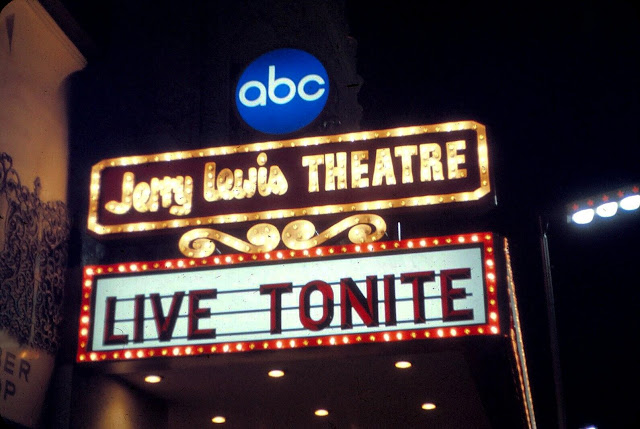




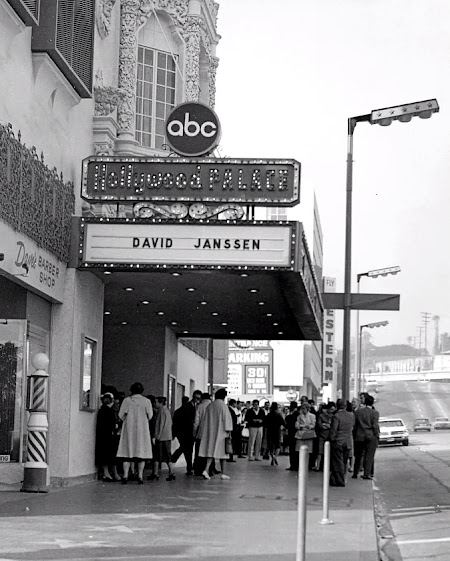









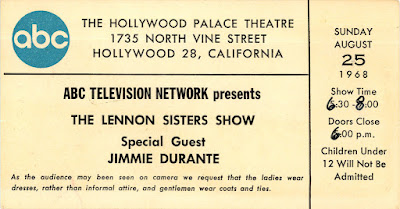


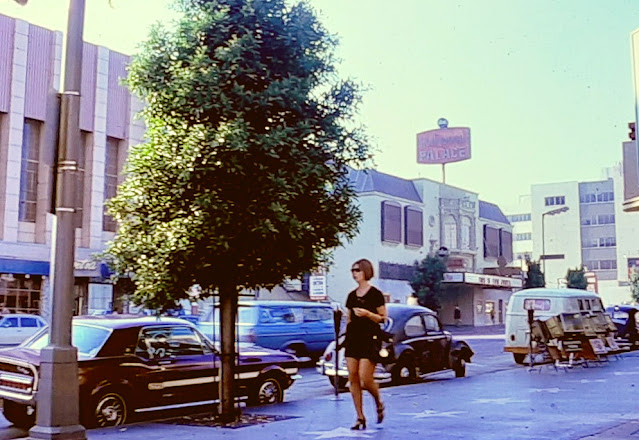

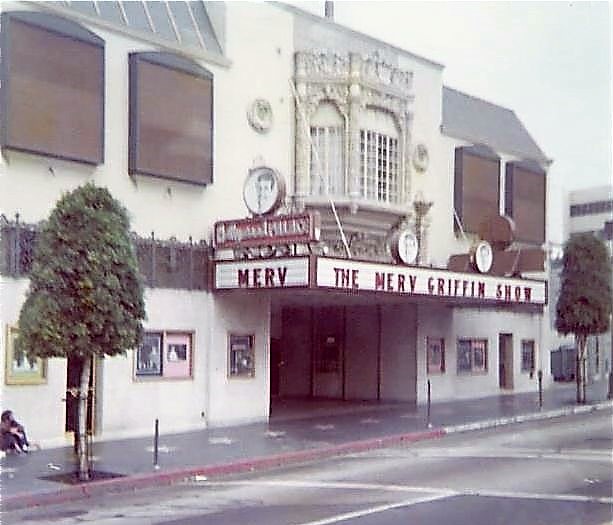































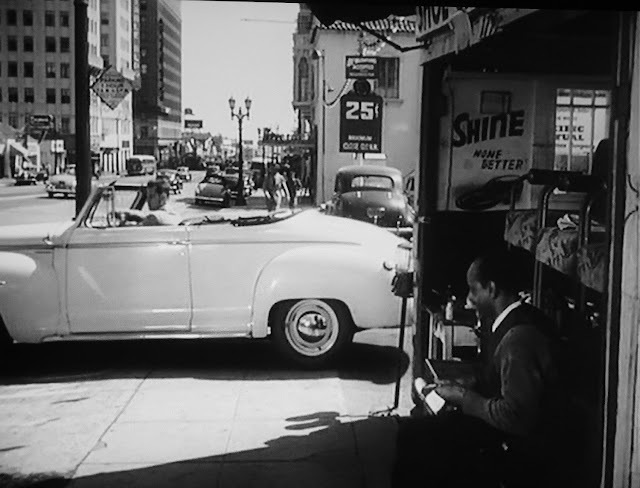

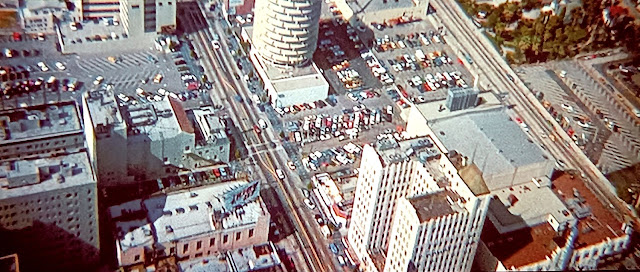




Morgan, Walls, and Clements had designs for four building as posted on Noirish Los Angeles. This included a Vine Street post office and a Rosenkranz Building, that of which appears to be a theater design. Perhaps that was how the mistaken credit was given? The actual 1925 era post office is documented in many of your photos as it was adjacent and south of the playhouse. It was replaced in 1935 by the next one. For a time, the Hollywood Secretarial School (founded 1919) was located in that post office building (1926-unknown). [Janet Gaynor was reportedly a graduate of the school.] We see it in these photos being altered and used for the “Airport Ground School” as well as a cafeteria location. Originally with seven upstairs windows, it seems to have been expanded backwards early on.
ReplyDeleteThanks for all the research. I must confess that the post office/cafeteria building isn't one that I had paid a lot of attention to. Good to have some data on it. Cheers!
Delete